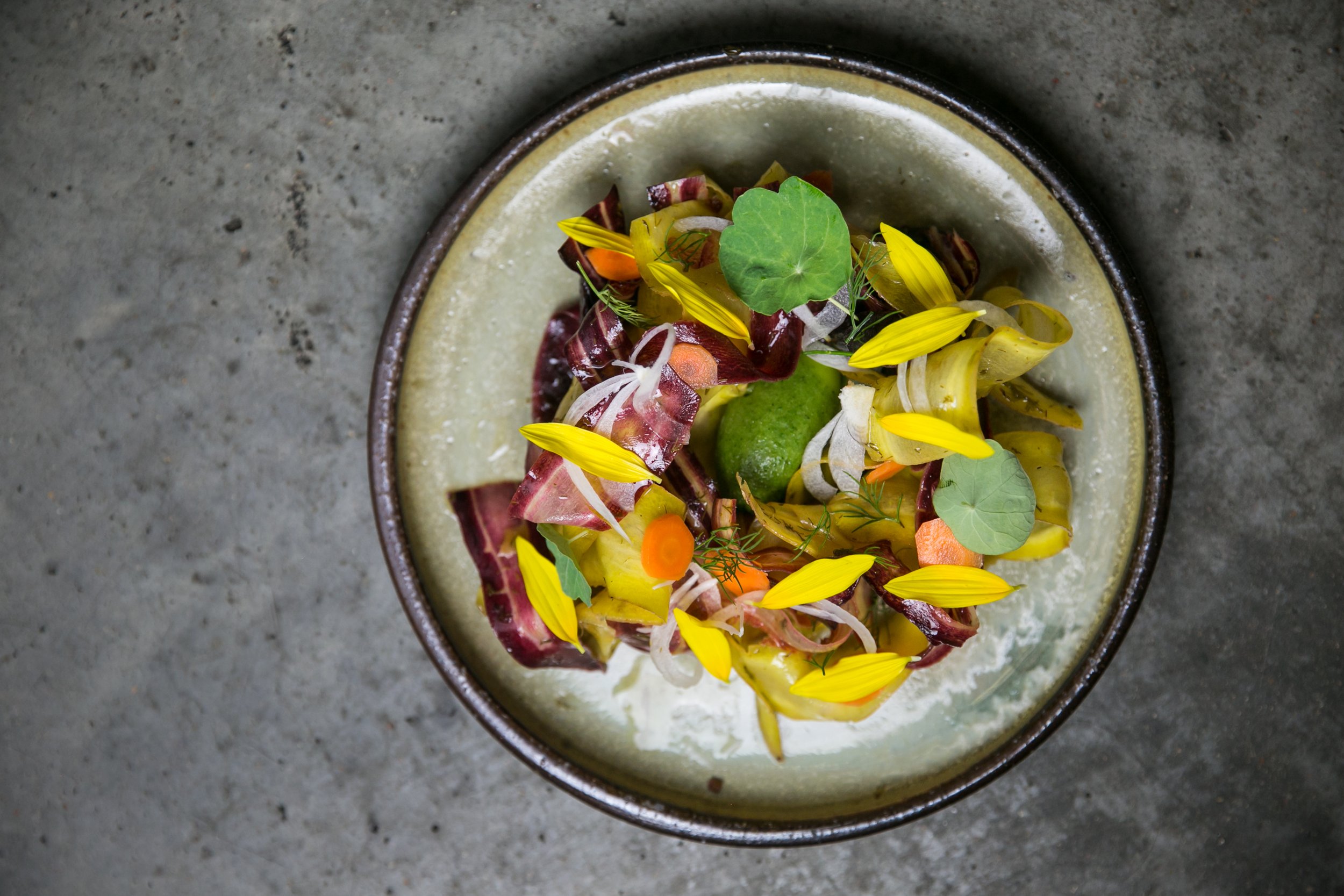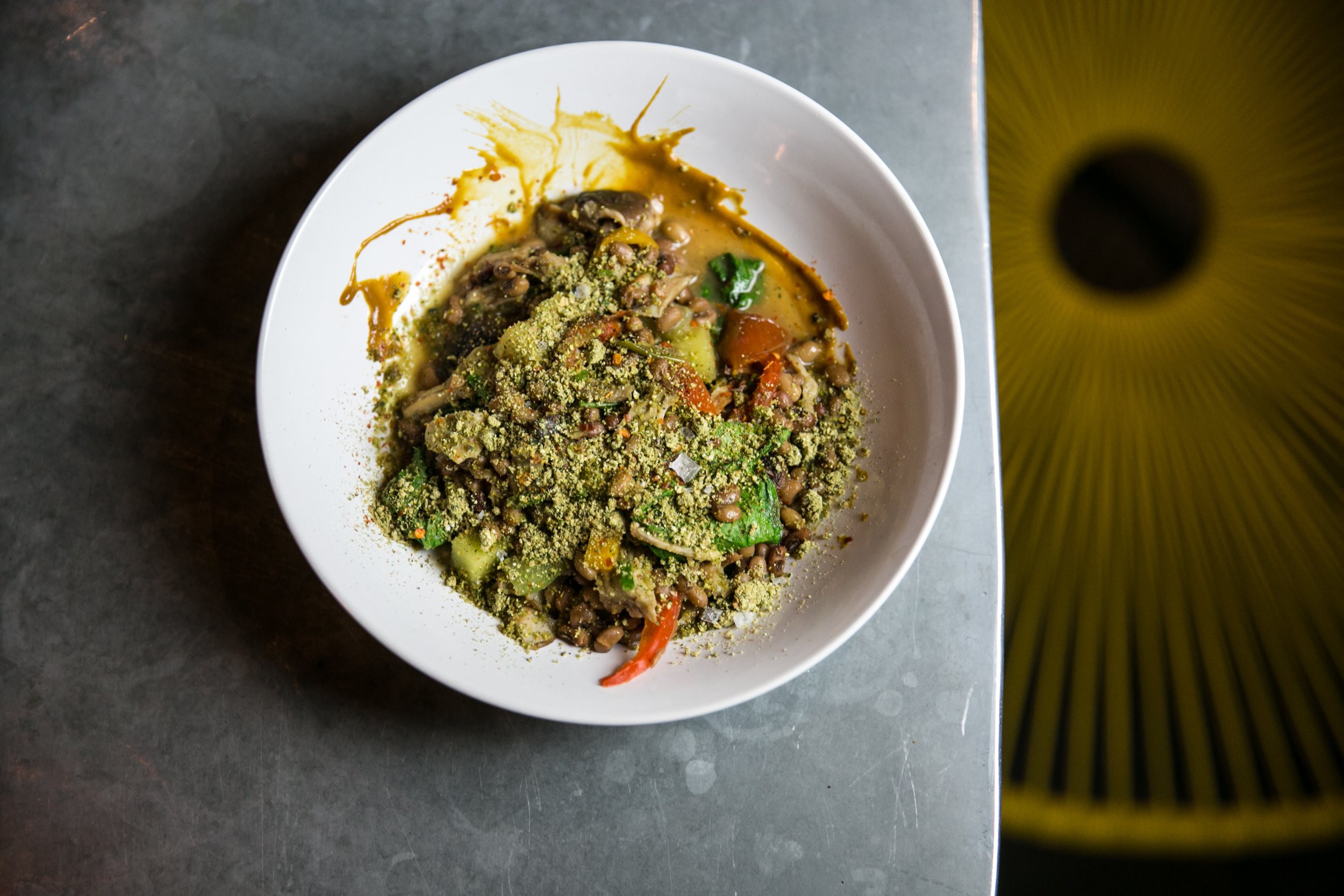Flavor Farm
At Emmer & Rye, saving scraps and reducing waste leads to new techniques, ingredients, and flavor compounds.
Smoked Carrot, Onion, Dill Lardo, and Arugula
There’s a point during lacto-fermentation at which green tomatoes taste like green olives. A parsnip, when fermented and dried in a particular manner, no longer tastes of parsnip, but of salty vanilla. “We’re not running out of flavors here. The most exciting product we have is always the one we’re going to have a year from now,” says Kevin Fink, co-chef of Austin’s Emmer & Rye with Page Pressley. “The idea is the best thing about it, not the product. It’s all about the approach,” says Pressley.
Salt and pepper. Those are the only spices Fink and Pressley do not make in house. Although the last shift ends at 2am and first shift begins at 6am, their kitchen never stops working—something is always bubbling away, aging, curing, or drying, transforming proteins and sugars into intense, singular flavors.
The Emmer & Rye pantry is like no other in the world. “We have off-site space to set things aside, too, [and an on-site garden]. No meal here will ever be had by you or anybody else ever again. There are just too many variables. Produce changes significantly from day to day, and once you taste that, you can’t un-taste it,” says Pressley. “And saving food and being mindful with waste helps us get to new flavor compounds and new ingredients,” Fink says.
Fink and Pressley ferment and dry chile peppers for their house chile powders, but it’s what they do with the discarded pepper tops that’s dynamic. They’re too bitter to cook with, so the chefs lacto-ferment the tops in a 3 to 5 percent salt brine and then use the liquid as a base for sauces. They make kimchi with herb stems. Citrus rinds from the bar are blackened on low heat, for a long time, with controlled humidity, as with black garlic.
They even make a product from the by-product of a by-product: house “bottarga.” But before you get to the bottarga, you’ve got to bake some bread and make room on the shelf for soy sauce. The chefs brew “soy sauce” by fermenting burnt bread scraps in a koji brine for months. The sauce leaves behind a by-product of hyperbolic flavor they call “bread mulch.” Fink and Pressley wanted to get at this neon hue of umami, but first they had to figure out how to transform the mulch into a more appealing, useable texture. They thought of the old hat technique of curing egg yolks to grate over a dish. To achieve that aesthetic and bump up the flavor, they puréed the yolks and mulch together and let the mixture cure for a day and then dry for two.
White Sonora Gondolini, Ricotta, Tomato Water, and Basil
Red Shrimp, Cured Cabbage, Radish, Onion, and Garlic
By the end of Emmer & Rye’s first year in fall 2016, Fink and Pressley had generated more than 400 dishes for their menu, rarely, if ever, repeating one since. “We have a very high labor model,” Fink says. “But we invest in labor and make up for that cost with [our approach] to food.” When you’re making a sellable product from the by-product of a by-product, you’re making money from nothing.
Emmer & Rye employees work four (long) days and have three days off. “By the time staff has been here for a year, the way they think about making sauces and other foods has changed,” says Pressley. “It’s easy to talk about rhubarb and minimizing bitterness, but we trust them to take the right steps because they are trained to work consistently with different ingredients.” Staff who have moved on say the number one thing they learned at Emmer & Rye is how to taste, “… really taste, and bring something into your palate and know why it tastes that way. And then know how to manipulate it, and when to leave it alone.” The chefs say they typically train a new employee for three months before they can trust them to process an ingredient.
“When you hear about all these things, you’d expect high prices,” Pressley says, “but our check average is $55, all in with pairings. We wanted to prove to ourselves and to our cooks and chefs around the world that this style of dining doesn’t have to be for elites, or only for chefs who have dedicated their lives to this kind of food, and have security.”
You can order à la carte at Emmer & Rye, or a four-top can dine dim sum-style and eat everything Fink, Pressley, and team have prepared that night—all 27 courses. “You have to buck the model in some way,” Fink says. “If you’re doing what everyone else is doing, you’ll just be as successful as them, that’s it. You have to put a premium on quality of product and be reasonable. [This type of dining experience] should never be exclusive.”
Interior of Emmer & Rye
Pork Shoulder, Tare, Kohlrabi, and Benne Seeds
House “Bottarga” at Emmer & Rye
Collect bread scraps.
Burn bread scraps.
Add to 10 percent salt brine.
Inoculate with koji brine.
Wait 4 months.
Drain.
Use liquid as house soy sauce.
Reserve solids (aka “bread mulch”).
Purée bread mulch with egg yolks.
Let cure 24 hours.
Dry for 2 days at 200ºF.
At pick-up, make it snow “bottarga.”







